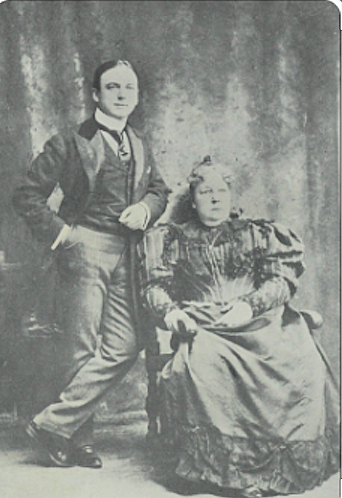A million-selling song from 125 years ago was actually inspired by West Cork flowers, which were spotted by an American tugboat stoker on holidays here. But that wasn’t his most famous song, – by a long shot – writes ROBERT HUME

WHILE staying in Glengarriff with his wife and mother, a man with the unlikely-sounding name of Chauncey (Chancellor) Olcott spotted clusters of pale pink wildflowers in the hedges.
His mother Peggy, born in Killeagh, East Cork, had left the little family cottage during the Great Hunger when still a child, and had been taken to the USA, to live in a wooden cabin in Lockport, New York State.
 Chauncey and his mother Peggy, who was born in Killeagh, Co Cork. (Chauncey photo: courtesy Tim Bohen)
Chauncey and his mother Peggy, who was born in Killeagh, Co Cork. (Chauncey photo: courtesy Tim Bohen)
At 16, she had married Mellon Olcott, who owned a bar and tugboat business in the canal district of Buffalo.
Chauncey was reputedly born over his father’s horse stable on July 21st, 1858. His ‘humble beginnings make his success much more improbable’, comments historian Tim Bohen. As a child, he loved to sing.
At four, he made such an impression when he performed an Irish ballad solo at St Michael’s School that his services were called upon whenever dignitaries visited Buffalo.
His youth was beset by tragedy: his father either died, or abandoned the family; his grandfather drowned in a canal; and his five-year-old brother William succumbed to illness. Only Chauncey was left to help Peggy run the tugboat outfit.
One day, while shovelling coal, his shirt caught fire. He took it as a sign that he was in the wrong job! When he told his mother that he planned to take to the stage, she thought he was bonkers.
At 21, Chauncey left Buffalo, blacked himself up, and began work with a minstrel company in Chicago. Later, he turned his thoughts to opera. But in 1890, on route to Milan, fate changed the course of his life.
Caught in a fierce storm, he jumped ship in London, where he found his forte as an Irish ‘singer comedian’ before returning to the USA a few months later.
The great Irish-American tenor William J Scanlon remarked that Olcott’s voice ‘has a brogue thicker than mine’.
When Scanlon fell ill in 1893, Chauncey took his part in the comedy-drama Mavourneen. The audience was spellbound, and President Grover Cleveland invited him to sing at the White House.
Over the next three decades, America’s silver-tongued Irish tenor shot to stardom, appearing in 20 major plays, and becoming known as the ‘Irish Thrush’.
In her biography of Olcott (Song in His Heart, 1939), his wife Rita, whom he’d married in 1897, describes how she accompanied Chauncey and his mother to Ireland the following year.
When visiting Killeagh, they were like ‘three alien Irish who had come home’.
But Peggy was not interested in spending the rest of her days in Ireland. ‘I’d rather stay at 662 West Avenue, Buffalo,’ she retorted.
Taking the ‘Prince of Wales route’ from Bantry Bay to Glengarriff, they arrived at the Eccles Hotel.
When a ‘dreamy-faced’ boy offered to row them across the bay, Chauncey said he’d prefer to hear some ‘good old Irish song’.
The boy proceeded to give them song after song in a strong Gaelic voice.
The only polite way of shutting him up was to ask him questions.
‘What kind of flowers are those pale pink ones over there, lad?’ inquired Rita.
‘Why, ma’am, don’t you know what thim are?’ replied the boy. ‘Thim are wild Irish roses ...’ Grasping Chauncey’s lapel, and pulling the stem of a little rose through the buttonhole, she exclaimed: ‘Chauncey … there’s your title, Wild Irish Rose!’
After dinner, he began composing by candlelight the words of My Wild Irish Rose. ‘But the melody would not come to him,’ recalled Rita.
Chauncey still couldn’t think of a tune even when it was time to go home. But he’d managed it by the time the ship reached New York.
The song featured in the musical A Romance of Athlone, which opened on Broadway in 1899. Although not an immediate success, it was destined to become a million-seller hit.
Yet, it was another of Chauncey’s songs which is more famous today: When Irish Eyes Are Smiling occupied the ‘number one’ slot for the whole of 1913. His mother would have rued the day she threw cold water on his youthful ambitions.
By his death on March 18th 1932, Chauncey had performed in front of millions. Historian and author Tim Bohen said he’d also ‘elevated’ the stereotypical perception of an Irishman, turning a gormless, drunken ruffian, into a witty and handsome gentleman.
With his huge fortune from songs and box office successes, he’d built a beautiful townhouse in Manhattan (worth about $8m today), and a villa overlooking the Mediterranean in Monte Carlo, which he and Rita travelled to every winter in a chauffeur-driven Rolls Royce.
But Chauncey never forgot his Irish roots. On his Saratoga Springs estate, where the couple spent their summers, he constructed a charming replica of his mother’s cottage back in Cork. No surprise if among the flowers festooning the cottage was a good supply of roses!
• With thanks to Tim Bohen for providing sources.










